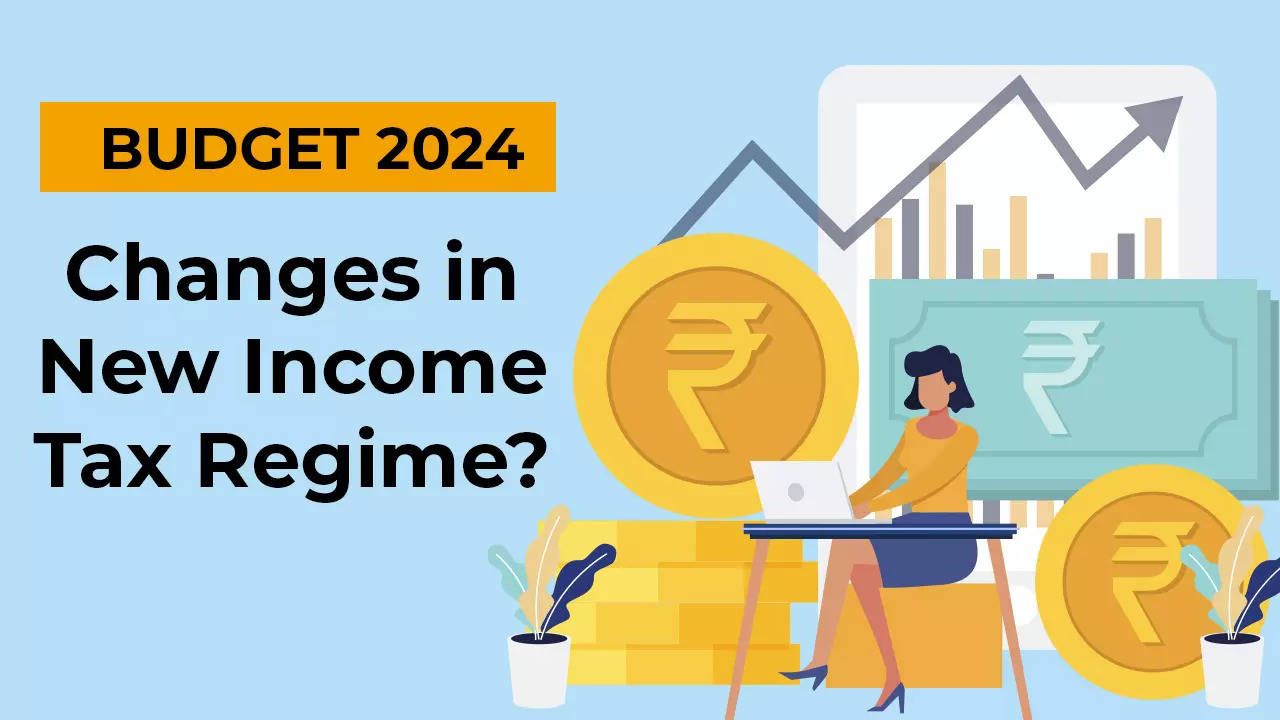Business
Budget 2024 income tax: New vs old tax regime – how FM Sitharaman can make simplified tax regime more appealing for taxpayers | Business

[ad_1]
By Aarti Raote and Poornima G
Budget 2024 income tax expectations: The new and simplified personal income tax regime was introduced in the Budget of 2020 with the objective to simplify tax compliances and provide significant relief to individual taxpayers. The new tax regime provided for significantly reduced income tax rates for individual taxpayers who will have to forgo certain deductions and exemptions.
Comparison between the regular tax regime and the simplified new tax regime
The Budget of 2023, further increased the personal income tax rebate threshold under the new tax regime from Rs 5 lakh to Rs 7 lakh, lowered the number of tax slabs from six to five, and increased the tax exemption ceiling to Rs 3 lakh. The highest surcharge rate was lowered from 37% to 25%, a standard deduction of Rs 50,000 was introduced for retirees and salaried individuals, and a family pension exemption of Rs 15,000 was implemented. However, as a consequence a taxpayer opting for the new tax regime shall forgo deductions such as House Rent Allowance, Leave Travel allowance, deduction for interest on housing loans, deductions u/s 80C for investments in ELSS, term deposits, housing loan principal etc.
Also Read | Budget 2024 Expectations Live Updates: Focus on infrastructure, income tax relief, job creation?
If the tax deductions/ exemptions in the regular regime is Rs 2 lakh or more for a salaried taxpayer having a total income of Rs 7 lakh, then his tax payable would be equal to the tax as per the simplified tax regime. For a taxpayer having a total income of Rs 15 lakh, the amount of deductions should be approximately Rs 3.75 lakh, to equate the tax number as per simplified tax regime. Thus taxpayers with higher levels of deductions will find the regular regime more beneficial. However, taxpayers at high income bands of Rs 5 crore and above, would prefer the new tax regime on account of the lower surcharge rate applicable.
While the new simplified regime was made as the default tax regime, the current tax regime is still in place, and a taxpayer has the option to choose the best suitable one.
Impact of the simplified tax regime
Based on the statistics shared till FY: 2021-22, the simplified tax regime was not preferred by many taxpayers. Hence the finance minister, in Budget 2023, added a few concessions to make the regime more attractive. It is expected that for FY 2023-24, at least 40% of the taxpayers will opt for the simplified tax regime.
Also Read | Budget 2024: Why standard deduction for salaried taxpayers needs to be hiked
The question that arises is whether the simplified tax regime has an impact on the tax savings investments made by taxpayers. One of the advantages of the regular regime was that it provided tax deduction for notified long term investments. Thus taxpayers invested in the Public Provident Fund (PPF) or life insurances and in long term fixed deposits, to save tax.
As of August 2023, the number of subscribers under the National Pension System (NPS) and Atal Pension Yojana (APY) together, have grown to more than 6.62 crore and the total Assets Under Management (AUM) has reached Rs. 10 lakh crore. The contributing members to the Employee’s Provident Fund (EPF) has increased to 7,62,25,799 over the last one year.
The number of subscribers to EPF as well as NPS reflect increased / growing subscriptions. However, one needs to watch out for future trends given that it is expected that 40% of taxpayers may move to the simplified tax regime. While the simplified tax regime does provide taxpayers the flexibility to invest their money in securities they prefer, one cannot deny that the investment decisions of lower income taxpayers could get impacted as these taxpayers have a tendency to choose the safer and the most used routes of investment such as PPF, NPS and insurance premiums, that also provide a tax break.
Consumer spending depends on a variety of factors such as level of income, savings, debt levels, future expectations etc., while at lower levels, there would be marginal benefit of using the simplified tax regime; at higher levels of income the benefit is significant because of surcharge rates. In such cases there is a higher disposable income with taxpayers, thus more purchasing power, which will aid in boosting demand for goods and services / increased investments. That will help stimulate economic growth.
Also Read | Budget 2024 Income Tax: How taxpayers can be given relief
Conclusion
The new simplified regime offers simplified tax structure with reduced documentation. The government should consider implementing the changes gradually and allow time for taxpayers to adjust and plan their taxes better.
To enhance the appeal of the new tax regime, the government needs to strike a balance between simplification, incentivization for savings and investments and stimulating consumer spending, all while maintaining fiscal sustainability. Continuous monitoring and adjustments based on feedback will be essential for its success.
(Aarti Raote is Partner with Deloitte Haskins & Sells LLP, Poornima G with Deloitte Haskins & Sells LLP)
Budget 2024 income tax expectations: The new and simplified personal income tax regime was introduced in the Budget of 2020 with the objective to simplify tax compliances and provide significant relief to individual taxpayers. The new tax regime provided for significantly reduced income tax rates for individual taxpayers who will have to forgo certain deductions and exemptions.
Comparison between the regular tax regime and the simplified new tax regime
The Budget of 2023, further increased the personal income tax rebate threshold under the new tax regime from Rs 5 lakh to Rs 7 lakh, lowered the number of tax slabs from six to five, and increased the tax exemption ceiling to Rs 3 lakh. The highest surcharge rate was lowered from 37% to 25%, a standard deduction of Rs 50,000 was introduced for retirees and salaried individuals, and a family pension exemption of Rs 15,000 was implemented. However, as a consequence a taxpayer opting for the new tax regime shall forgo deductions such as House Rent Allowance, Leave Travel allowance, deduction for interest on housing loans, deductions u/s 80C for investments in ELSS, term deposits, housing loan principal etc.
Also Read | Budget 2024 Expectations Live Updates: Focus on infrastructure, income tax relief, job creation?
If the tax deductions/ exemptions in the regular regime is Rs 2 lakh or more for a salaried taxpayer having a total income of Rs 7 lakh, then his tax payable would be equal to the tax as per the simplified tax regime. For a taxpayer having a total income of Rs 15 lakh, the amount of deductions should be approximately Rs 3.75 lakh, to equate the tax number as per simplified tax regime. Thus taxpayers with higher levels of deductions will find the regular regime more beneficial. However, taxpayers at high income bands of Rs 5 crore and above, would prefer the new tax regime on account of the lower surcharge rate applicable.
While the new simplified regime was made as the default tax regime, the current tax regime is still in place, and a taxpayer has the option to choose the best suitable one.
Impact of the simplified tax regime
Based on the statistics shared till FY: 2021-22, the simplified tax regime was not preferred by many taxpayers. Hence the finance minister, in Budget 2023, added a few concessions to make the regime more attractive. It is expected that for FY 2023-24, at least 40% of the taxpayers will opt for the simplified tax regime.
Also Read | Budget 2024: Why standard deduction for salaried taxpayers needs to be hiked
The question that arises is whether the simplified tax regime has an impact on the tax savings investments made by taxpayers. One of the advantages of the regular regime was that it provided tax deduction for notified long term investments. Thus taxpayers invested in the Public Provident Fund (PPF) or life insurances and in long term fixed deposits, to save tax.
As of August 2023, the number of subscribers under the National Pension System (NPS) and Atal Pension Yojana (APY) together, have grown to more than 6.62 crore and the total Assets Under Management (AUM) has reached Rs. 10 lakh crore. The contributing members to the Employee’s Provident Fund (EPF) has increased to 7,62,25,799 over the last one year.
The number of subscribers to EPF as well as NPS reflect increased / growing subscriptions. However, one needs to watch out for future trends given that it is expected that 40% of taxpayers may move to the simplified tax regime. While the simplified tax regime does provide taxpayers the flexibility to invest their money in securities they prefer, one cannot deny that the investment decisions of lower income taxpayers could get impacted as these taxpayers have a tendency to choose the safer and the most used routes of investment such as PPF, NPS and insurance premiums, that also provide a tax break.
Consumer spending depends on a variety of factors such as level of income, savings, debt levels, future expectations etc., while at lower levels, there would be marginal benefit of using the simplified tax regime; at higher levels of income the benefit is significant because of surcharge rates. In such cases there is a higher disposable income with taxpayers, thus more purchasing power, which will aid in boosting demand for goods and services / increased investments. That will help stimulate economic growth.
Also Read | Budget 2024 Income Tax: How taxpayers can be given relief
Conclusion
The new simplified regime offers simplified tax structure with reduced documentation. The government should consider implementing the changes gradually and allow time for taxpayers to adjust and plan their taxes better.
To enhance the appeal of the new tax regime, the government needs to strike a balance between simplification, incentivization for savings and investments and stimulating consumer spending, all while maintaining fiscal sustainability. Continuous monitoring and adjustments based on feedback will be essential for its success.
(Aarti Raote is Partner with Deloitte Haskins & Sells LLP, Poornima G with Deloitte Haskins & Sells LLP)
#Budget #income #tax #tax #regime #Sitharaman #simplified #tax #regime #appealing #taxpayers #Business





